| |
Indiana University Southeast BFA Graphic Design Aug - Dec - 2019
Syllabus for a senior-level BFA Graphic Design (S452) and BA (451), Indiana University Southeast, New Albany, Indiana, USA for the spring semester from Aug - Dec 2019.
Download: S451 452 BA BFA GD syllabus FA19.pdf

1st project: Designed To Inform
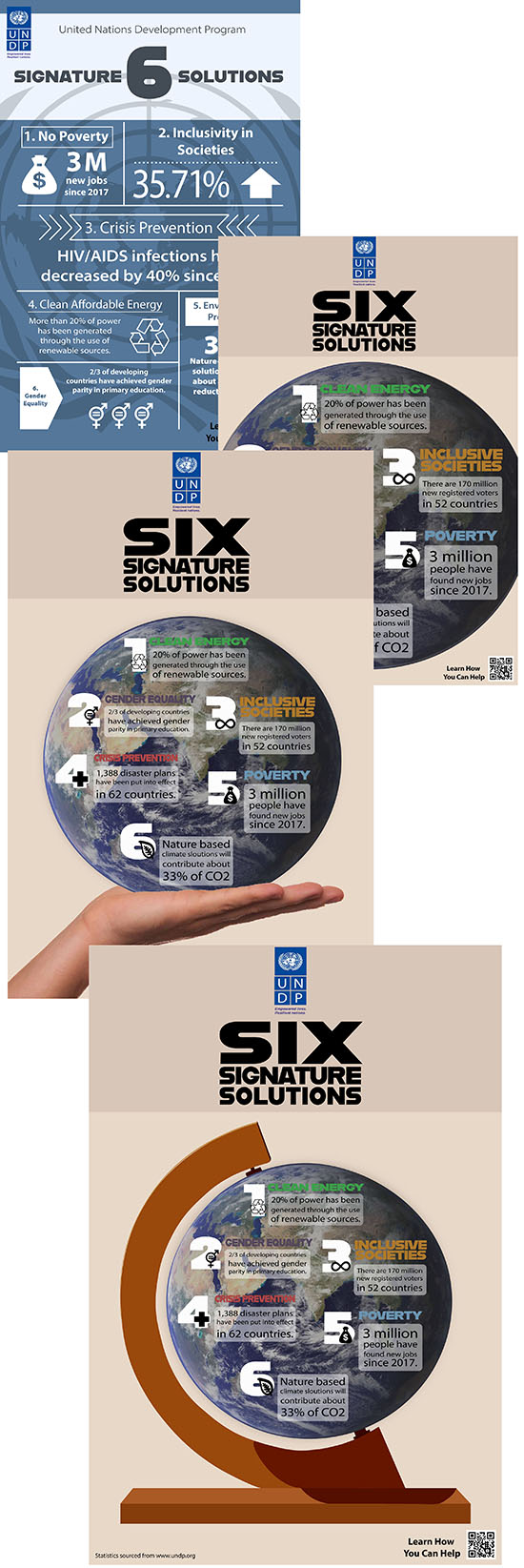
The idea of infographics is to communicate complex data into information that can be easily understood in visual forms. It can be a pleasing arrangement of facts and figures in a table to a complex diagram with accompanying text. Using publicly available data or social awareness issues, we will create take complex information and present them as graphics (through the combination of pictography and typography) meant to educate or inform the public.
Using information from the United Nations Development Programme (UNDP), available here: https://www.undp.org/content/undp/en/home/six-signature-solutions.html, visually construct an information graphics chart to show how the 'Six Signature Solutions' can help to achieve the 2030 Agenda. Stylistically, they explored illustration, photo-based imagery, or graphics and the stylistic choice they ended up choosing should reflect the tone of the message-serious, high-spirited, or light-hearted. Shown here are some digital versions before Erin Korb ended up with the last one shown at the bottom.

2nd project: Designed To Surprise
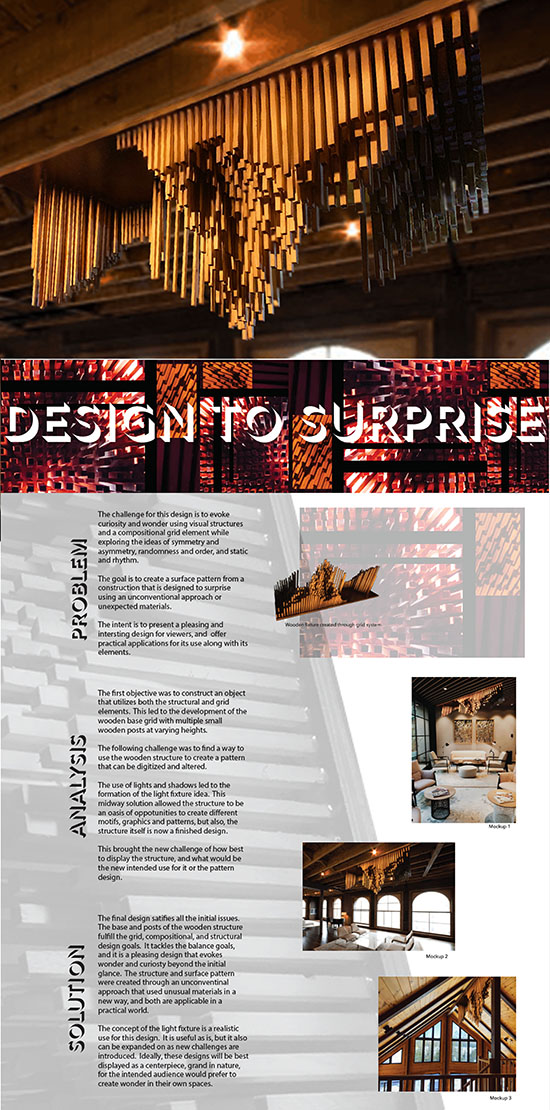
During the 2010 TED Talk, Canadian designer, typographer, writer, and illustrator, Marian Bantjes revealed that her work resonates with people because the appeal of her designs has ethereal qualities that evoke such questions in the viewers: does it bring joy, is there a sense of wonder, does it evoke curiosity? In a sense, she is referring to visual structures and a compositional grid structure that creates surprise through her use of unexpected materials and unconventional approaches. For this project of surface design, students are asked to model their design after Bantjes' use of geometry, ornamental typographic style, or found objects as explained in her videos (bantjes.com/about/video) to explore one of the following combinations: symmetry and asymmetry, randomness and order, figure and ground, and static and rhythm.
Kaitie Garing used many pieces of wood to create a voluminous texture which is presented here in her presentation poster to suggest that the texture could also be used as a form of lighting fixture.

3rd project: Designed To Sustain Or Retain?
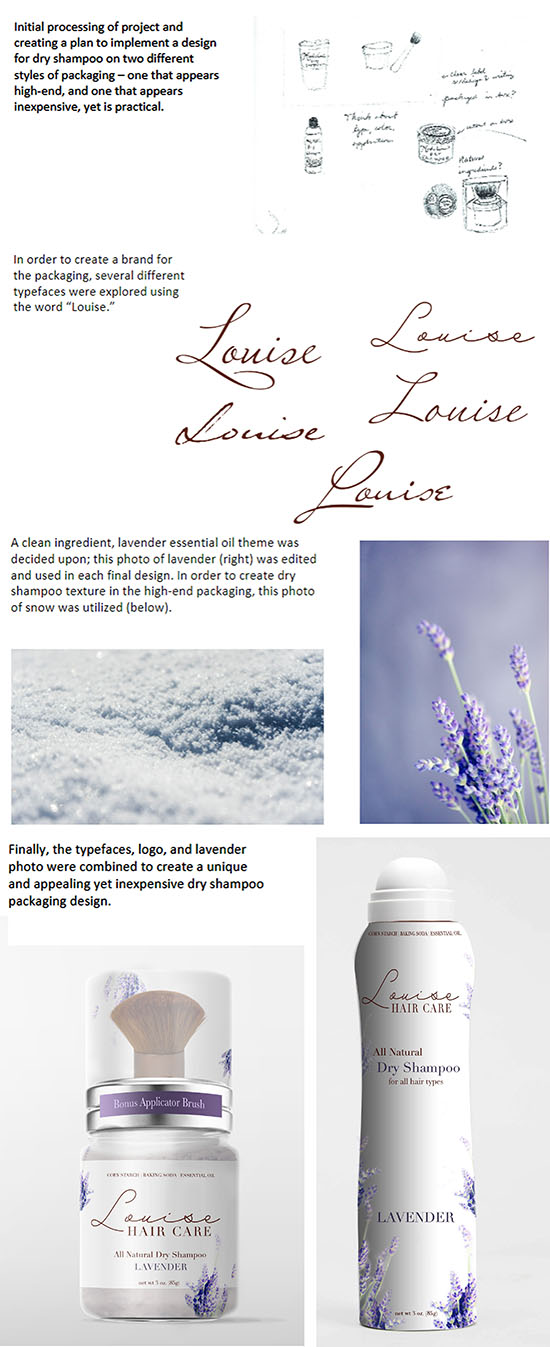
Graphic designers struggle with the issue of function vs. aesthetics, as an artisan vs. an artist. While the former encourages one to experiment, for self-discovery, so to speak, the latter requires the designer to produce work that is cost-effective, while relying on a method that is repeatable and reliable. As an experimental project, Madeline Baird designed a packaging based on a similar item for two different purposes: to sustain (as an artisan) or to retain (as an artist). The former is about producing a functional yet purposeful while latter is about producing a packaging that titillates our sensibilities, of one that elevates the packaging's status. Shown here are the description of her design processes.

4th Project: Designed To Delineate
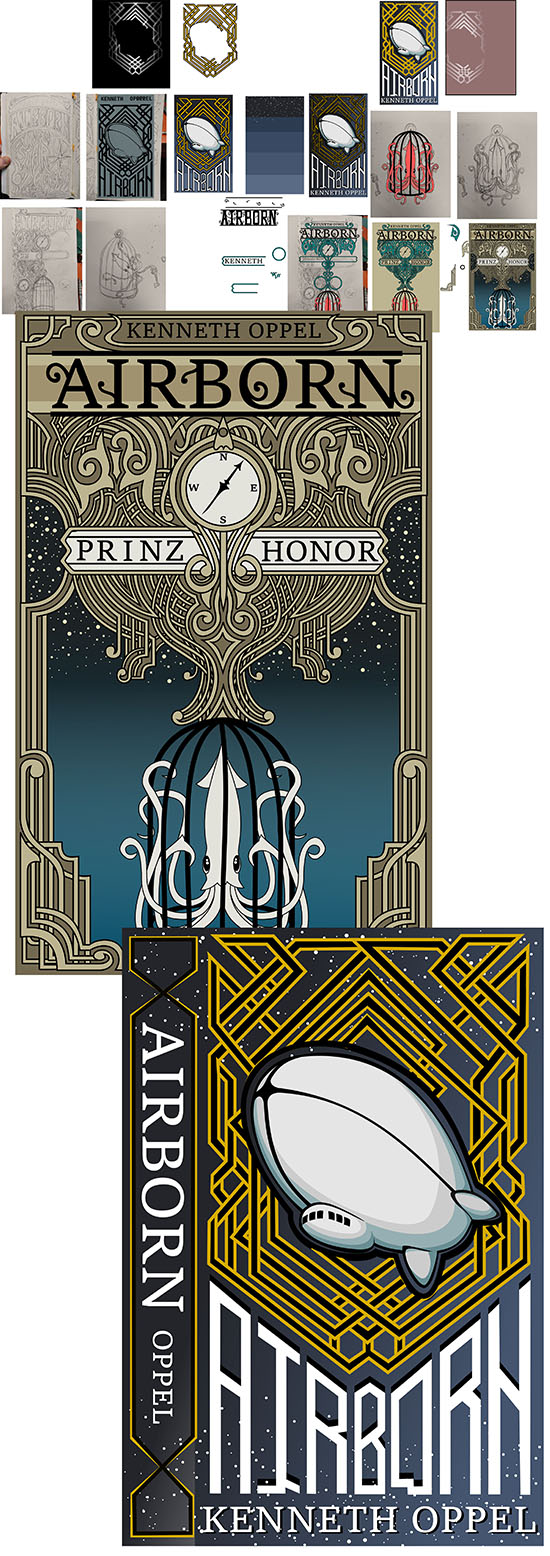
By delving into historical styles, the students were tasked to redesign a total of two book covers, based on one book, to reflect two different eras. Two key main 'ingredients' must be considered before other elements such as color or texture can be applied - typography and imagery that reflect the zeitgeist of the era. They were strongly urged to create original artwork and to refer to the chronological order of the different eras below for inspirations:
- Victorian Graphic Design Style: 1837-1901
- Arts & Crafts Graphic Design Style:1880-1910
- Art Nouveau Graphic Design Style: 1890-1920
- Futurism Graphic Design Style: 1900-1930s
- Art Deco Graphic Design Style: 1920-1940s
- Heroic Realism Graphic Design Style: 1900-1940s
- Early Modern Graphic Design Style: 1910-1935
- Late Modern Graphic Design Style: 1945-1960
- American Kitsch Graphic Design Style: 1950s
- Swiss/International Graphic Design Style: 1940s-1980s
- Psychedelic Graphic Design Style: 1960s
- Post Modern Graphic Design Style: 1970s-1980s
- Grunge Graphic Design Style: 2000-2010s
- Flat Graphic Design Style: 2010-Present
(Source: http://www.onlinedesignteacher.com/2016/05/graphic-design-timeline.html). Bailey Morrison explored the Victorian and Art Deco styles for two book covers shown here.

Designed To Delineate
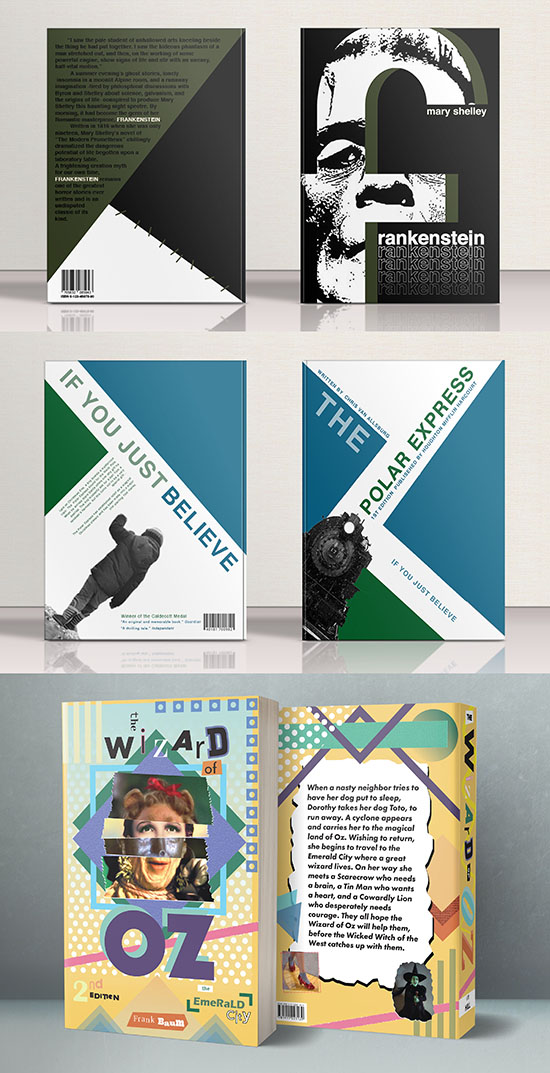
Ashley Berry's (top) take on Swiss International on a book titled Frankenstein and while Brianna Dixon also banks on the angular composition, both her Polar Express front and back covers are angularly composed to have both the text and images to comply with the dynamic composition. Erin Korb's presentation for her book on the Wizard of Oz based on Post Modern graphic design style which ocurred around the 1970s - 1980s.

5th Project: D.I.Y. (Decide It Yourself)
A final project is a broad-based approach that provides an opportunity to exercise your own judgment and decision-making skills. Consult with your professor ahead of time and to obtain guidance/approval to begin. In order to avoid any mad rush towards the finals, please discuss your decision for this final project at least 2-3 weeks before the 4th projectís deadline on 11/12/18.
Here are three options which require you to discuss them with the professor for the deliverables:
1. EXPANSION OF PROJECTS. Expand one of your previous projects to include at least two pieces of touchpoints.
2. CLIENT-BASED. Work with an assigned or self-sourced client to produce an end result of some sort towards the end of the semester.
3. PROCESS DOCUMENTATION. Create a comprehensive documentation process in a digital format that documents one of the four projects from this course. These steps must be professional in appearance with minimal text in the succession of steps: research (identifying and defining the problem, mostly in a written form), sketches (concept development in early stages, multiple options explored), refinement (sketches refined, colors explored, type explored, etc), selection (steps involved in the selection process), prototyping (creating the mockup), and finally, the end product (presentation of the idea in its professional and real-life context).

|
|
YEOH AS EDUCATOR
- MY STUDENTS' CREATIONS
- MY WRITINGS
Select below to view my students' awards as well as their creations from Nanyang Technological University, Texas Tech University, and Southern Arkansas University.
|